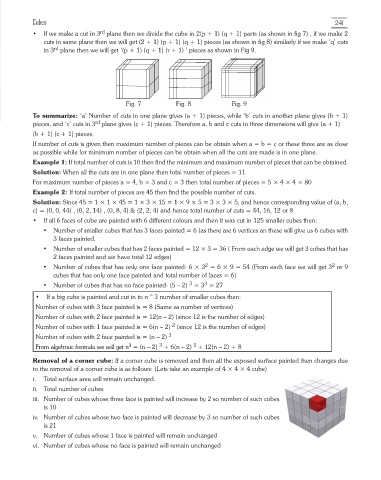Page 245 - Services Selection Board (SSB) Interviews
P. 245
Cubes 241
rd
• If we make a cut in 3 plane then we divide the cube in 2(p + 1) (q + 1) parts (as shown in fig 7) , if we make 2
cuts in same plane then we will get (2 + 1) (p + 1) (q + 1) pieces (as shown in fig 8) similarly if we make ‘q’ cuts
rd
in 3 plane then we will get ‘(p + 1) (q + 1) (r + 1) ’ pieces as shown in Fig 9.
Fig. 7 Fig. 8 Fig. 9
To summarize: ‘a’ Number of cuts in one plane gives (a + 1) pieces, while ‘b’ cuts in another plane gives (b + 1)
rd
pieces, and ‘c’ cuts in 3 plane gives (c + 1) pieces. Therefore a, b and c cuts in three dimensions will give (a + 1)
(b + 1) (c + 1) pieces.
If number of cuts is given then maximum number of pieces can be obtain when a = b = c or these three are as close
as possible while for minimum number of pieces can be obtain when all the cuts are made is in one plane.
Example 1: If total number of cuts is 10 then find the minimum and maximum number of pieces that can be obtained.
Solution: When all the cuts are in one plane then total number of pieces = 11
For maximum number of pieces a = 4, b = 3 and c = 3 then total number of pieces = 5 × 4 × 4 = 80
Example 2: If total number of pieces are 45 then find the possible number of cuts.
Solution: Since 45 = 1 × 1 × 45 = 1 × 3 × 15 = 1 × 9 × 5 = 3 × 3 × 5, and hence corresponding value of (a, b,
c) = (0, 0, 44) , (0, 2, 14) , (0, 8, 4) & (2, 2, 4) and hence total number of cuts = 44, 16, 12 or 8
• If all 6 faces of cube are painted with 6 different colours and then it was cut in 125 smaller cubes then:
• Number of smaller cubes that has 3 faces painted = 6 (as there are 6 vertices an these will give us 6 cubes with
3 faces painted.
• Number of smaller cubes that has 2 faces painted = 12 × 3 = 36 ( From each edge we will get 3 cubes that has
2 faces painted and we have total 12 edges)
2
2
• Number of cubes that has only one face painted- 6 × 3 = 6 × 9 = 54 (From each face we will get 3 or 9
cubes that has only one face painted and total number of faces = 6)
3
3
• Number of cubes that has no face painted- (5 – 2) = 3 = 27
• If a big cube is painted and cut in to n^3 number of smaller cubes then:
Number of cubes with 3 face painted is = 8 (Same as number of vertices)
Number of cubes with 2 face painted is = 12(n – 2) (since 12 is the number of edges)
2
Number of cubes with 1 face painted is = 6(n – 2) (since 12 is the number of edges)
Number of cubes with 2 face painted is = (n – 2) 3
2
3
3
From algebraic formula we will get n = (n – 2) + 6(n – 2) + 12(n – 2) + 8
Removal of a corner cube: If a corner cube is removed and then all the exposed surface painted then changes due
to the removal of a corner cube is as follows: (Lets take an example of 4 × 4 × 4 cube)
i. Total surface area will remain unchanged.
ii. Total number of cubes
iii. Number of cubes whose three face is painted will increase by 2 so number of such cubes
is 10
iv. Number of cubes whose two face is painted will decrease by 3 so number of such cubes
is 21
v. Number of cubes whose 1 face is painted will remain unchanged
vi. Number of cubes whose no face is painted will remain unchanged

